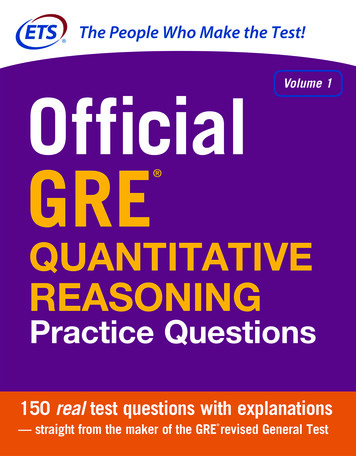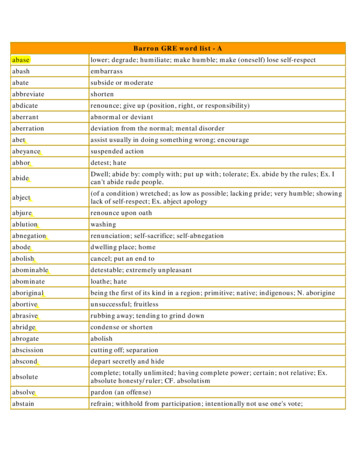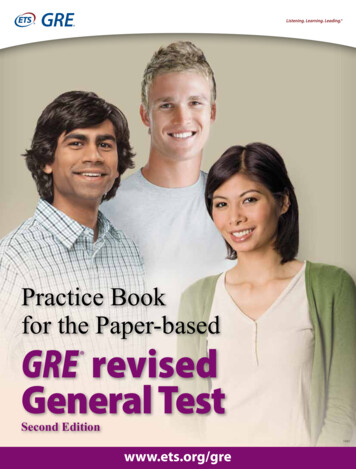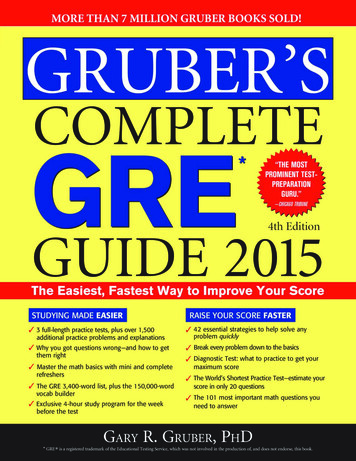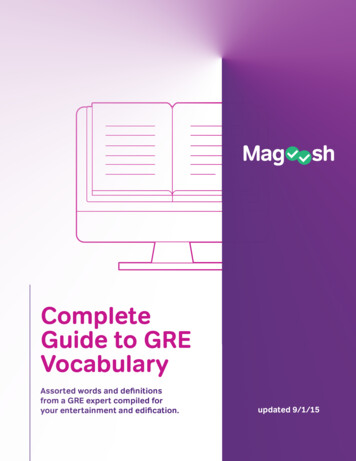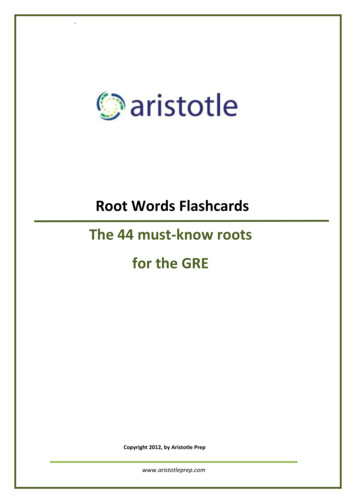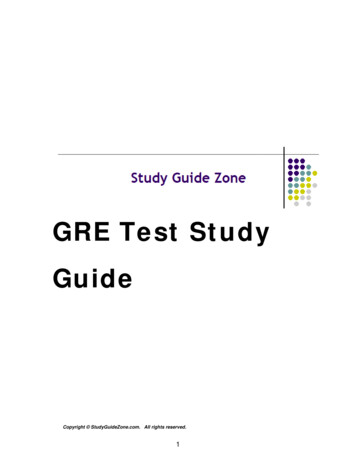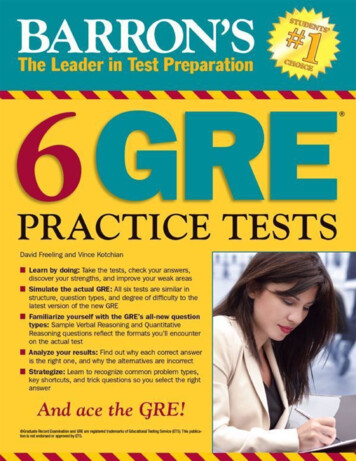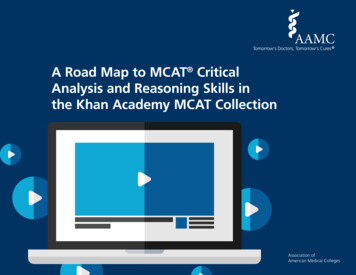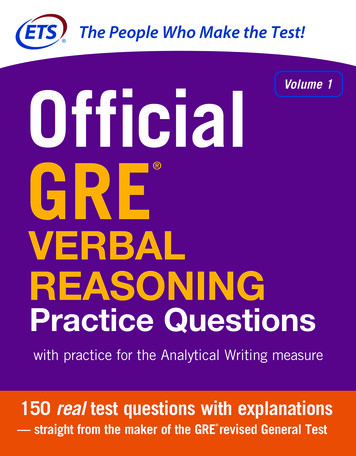
Transcription
Welcome toOfficialOfficicial GRE VerbalV rbal ReasoningVeReasonini g PracticePractiPrt cec Questions,Questit onsVolume 1The book you are holding offers 150 real GRE practice questions directly from the maker ofthe GRE revised General Test. This book is specially created to give you in-depth practiceand accurate test preparation for the Verbal Reasoning measure. Here’s what you will find inside: Authentic GRE Verbal Reasoning test questions arranged by question type anddifficulty level—to help you build your test-taking skills. Plus, mixed practice sets. Answers and explanations for every question! ETS’s own test-taking strategies. Learn valuable hints and tips that can help youget your best score. Official information on the GRE Verbal Reasoning measure. Get the facts aboutthe test content, structure, and scoring—straight from ETS. Plus: an overview of the GRE Analytical Writing measure with writing strategies,sample writing tasks, and sample scored essays.About ETSAt ETS, we advance quality and equity in education for people worldwide by creatingassessments based on rigorous research. ETS serves individuals, educational institutions,and government agencies by providing customized solutions for teacher certification,English language learning, and elementary, secondary, and post-secondary education,as well as conducting educational research, analysis, and policy studies. Founded as anonprofit in 1947, ETS develops, administers, and scores more than 50 million testsannually—including the TOEFL and TOEIC tests, the GRE tests, and The PraxisSeries assessments—in more than 180 countries at over 9,000 locations worldwide. Formore information, visit www.ets.org.
This page intentionally left blank
IMPORTANTETS makes available free test preparation materials for individuals planning to take a GRE test.POWERPREP II software is available for individuals planning to take the computer-deliveredGRE revised General Test, and the Practice Book for the Paper-based GRE revised GeneralTest, Second Edition, is available for individuals planning to take the paper-delivered test.The information about how to prepare for the Verbal Reasoning measure of the GRErevised General Test, test-taking strategies, question strategies, etc., that is included in thefree test preparation is also included in this publication. This publication also provides youwith 150 brand new practice questions with answers and explanations. For more information about the GRE revised General Test, free and low-costGRE test preparation materials, and other GRE products and services,please visit the GRE website at:www.ets.org/greInquiries concerning the practice test questions in this bookshould be sent to the GRE testing program at:GRETestQuestionInquiries@ets.org
This page intentionally left blank
Volume 1OfficialGRE VERBALREASONINGPractice Questionswith practice for the Analytical Writing measureNew York Chicago San Francisco Athens London MadridMexico City Milan New Delhi Singapore Sydney Toronto
Copyright 2014 by Educational Testing Service. All rights reserved. Except as permitted under the United States Copyright Act of 1976, no part of this publicationmay be reproduced or distributed in any form or by any means, or stored in a database or retrieval system, without the prior written permission of the publisher, with theexception that the program listings may be entered, stored, and executed in a computer system, but they may not be reproduced for publication.ISBN: 978-0-07-183430-8MHID: 0-07-183430-3The material in this eBook also appears in the print version of this title: ISBN: 978-0-07-183429-2,MHID: 0-07-183429-X.eBook conversion by codeMantraVersion 1.0All trademarks are trademarks of their respective owners. Rather than put a trademark symbol after every occurrence of a trademarked name, we use names in aneditorial fashion only, and to the benefit of the trademark owner, with no intention of infringement of the trademark. Where such designations appear in this book, theyhave been printed with initial caps.McGraw-Hill Education eBooks are available at special quantity discounts to use as premiums and sales promotions or for use in corporate trainingprograms. To contact a representative, please visit the Contact Us page at www.mhprofessional.com.ETS, the ETS logo, LISTENING, LEARNING, LEADING, E-RATER, GRADUATE RECORD EXAMINATIONS, GRE, POWERPREP, SCORE SELECT, TOEFL,and TOEIC are registered trademarks of Educational Testing Service in the United States and other countries and are used under license. THE PRAXIS SERIES is atrademark of Educational Testing Service and is used under license.TERMS OF USEThis is a copyrighted work and McGraw-Hill Education and its licensors reserve all rights in and to the work. Use of this work is subject to these terms. Except aspermitted under the Copyright Act of 1976 and the right to store and retrieve one copy of the work, you may not decompile, disassemble, reverse engineer, reproduce,modify, create derivative works based upon, transmit, distribute, disseminate, sell, publish or sublicense the work or any part of it without McGraw-Hill Education’sprior consent. You may use the work for your own noncommercial and personal use; any other use of the work is strictly prohibited. Your right to use the work may beterminated if you fail to comply with these terms.THE WORK IS PROVIDED “AS IS.” McGRAW-HILL EDUCATION AND ITS LICENSORS MAKE NO GUARANTEES OR WARRANTIES AS TO THEACCURACY, ADEQUACY OR COMPLETENESS OF OR RESULTS TO BE OBTAINED FROM USING THE WORK, INCLUDING ANY INFORMATION THATCAN BE ACCESSED THROUGH THE WORK VIA HYPERLINK OR OTHERWISE, AND EXPRESSLY DISCLAIM ANY WARRANTY, EXPRESS OR IMPLIED,INCLUDING BUT NOT LIMITED TO IMPLIED WARRANTIES OF MERCHANTABILITY OR FITNESS FOR A PARTICULAR PURPOSE. McGraw-HillEducation and its licensors do not warrant or guarantee that the functions contained in the work will meet your requirements or that its operation will be uninterrupted orerror free. Neither McGraw-Hill Education nor its licensors shall be liable to you or anyone else for any inaccuracy, error or omission, regardless of cause, in the work or forany damages resulting therefrom. McGraw-Hill Education has no responsibility for the content of any information accessed through the work. Under no circumstances shallMcGraw-Hill Education and/or its licensors be liable for any indirect, incidental, special, punitive, consequential or similar damages that result from the use of or inabilityto use the work, even if any of them has been advised of the possibility of such damages. This limitation of liability shall apply to any claim or cause whatsoever whethersuch claim or cause arises in contract, tort or otherwise.
Contents1How to Use This Book . . . . . . . . . . . . . . . . . . . . . . . . . . . . . . . . . . . . . . . . . . . . . . . . . . . . . . . . . . . xiOverview of the GRE Verbal Reasoning Measure 1Introduction to the GRE revised General Test . . . . . . . . . . . . . . . . . . . . . . . . . . . . . . . . . . . 1The Verbal Reasoning Measure of the Computer-deliveredGRE revised General Test . . . . . . . . . . . . . . . . . . . . . . . . . . . . . . . . . . . . . . . . . . . . . . . . . . 2The Verbal Reasoning Measure of the Paper-deliveredGRE revised General Test . . . . . . . . . . . . . . . . . . . . . . . . . . . . . . . . . . . . . . . . . . . . . . . . . . . . 4Score Reporting . . . . . . . . . . . . . . . . . . . . . . . . . . . . . . . . . . . . . . . . . . . . . . . . . . . . . . . . . . . . . . . 52Test Content7Overview of the Verbal Reasoning Measure . . . . . . . . . . . . . . . . . . . . . . . . . . . . . . . . . . . . . . 7Verbal Reasoning Question Types . . . . . . . . . . . . . . . . . . . . . . . . . . . . . . . . . . . . . . . . . . . . . . . 73Question Type 1: Reading Comprehension17Practice Set 1: Easy . . . . . . . . . . . . . . . . . . . . . . . . . . . . . . . . . . . . . . . . . . . . . . . . . . . . . . . . . . . 18Practice Set 2: Medium . . . . . . . . . . . . . . . . . . . . . . . . . . . . . . . . . . . . . . . . . . . . . . . . . . . . . . . . 22Practice Set 3: Hard . . . . . . . . . . . . . . . . . . . . . . . . . . . . . . . . . . . . . . . . . . . . . . . . . . . . . . . . . . . 28Answer Key . . . . . . . . . . . . . . . . . . . . . . . . . . . . . . . . . . . . . . . . . . . . . . . . . . . . . . . . . . . . . . . . . . 33Answers and Explanations . . . . . . . . . . . . . . . . . . . . . . . . . . . . . . . . . . . . . . . . . . . . . . . . . . . . . 35
4Question Type 2: Text Completion57Practice Set 1: Easy . . . . . . . . . . . . . . . . . . . . . . . . . . . . . . . . . . . . . . . . . . . . . . . . . . . . . . . . . . . 58Practice Set 2: Medium . . . . . . . . . . . . . . . . . . . . . . . . . . . . . . . . . . . . . . . . . . . . . . . . . . . . . . . . 61Practice Set 3: Hard . . . . . . . . . . . . . . . . . . . . . . . . . . . . . . . . . . . . . . . . . . . . . . . . . . . . . . . . . . . 63Answer Key . . . . . . . . . . . . . . . . . . . . . . . . . . . . . . . . . . . . . . . . . . . . . . . . . . . . . . . . . . . . . . . . . . 65Answers and Explanations . . . . . . . . . . . . . . . . . . . . . . . . . . . . . . . . . . . . . . . . . . . . . . . . . . . . . 665Question Type 3: Sentence Equivalence79Practice Set 1: Easy . . . . . . . . . . . . . . . . . . . . . . . . . . . . . . . . . . . . . . . . . . . . . . . . . . . . . . . . . . . 80Practice Set 2: Medium . . . . . . . . . . . . . . . . . . . . . . . . . . . . . . . . . . . . . . . . . . . . . . . . . . . . . . . . 82Practice Set 3: Hard . . . . . . . . . . . . . . . . . . . . . . . . . . . . . . . . . . . . . . . . . . . . . . . . . . . . . . . . . . . 85Answer Key . . . . . . . . . . . . . . . . . . . . . . . . . . . . . . . . . . . . . . . . . . . . . . . . . . . . . . . . . . . . . . . . . . 87Answers and Explanations . . . . . . . . . . . . . . . . . . . . . . . . . . . . . . . . . . . . . . . . . . . . . . . . . . . . . 886Mixed Practice Sets101Practice Set 1 . . . . . . . . . . . . . . . . . . . . . . . . . . . . . . . . . . . . . . . . . . . . . . . . . . . . . . . . . . . . . . . . 102Answer Key . . . . . . . . . . . . . . . . . . . . . . . . . . . . . . . . . . . . . . . . . . . . . . . . . . . . . . . . . . . . . 111Answers and Explanations . . . . . . . . . . . . . . . . . . . . . . . . . . . . . . . . . . . . . . . . . . . . . . . . 112Practice Set 2 . . . . . . . . . . . . . . . . . . . . . . . . . . . . . . . . . . . . . . . . . . . . . . . . . . . . . . . . . . . . . . . . 126Answer Key . . . . . . . . . . . . . . . . . . . . . . . . . . . . . . . . . . . . . . . . . . . . . . . . . . . . . . . . . . 135Answers and Explanations . . . . . . . . . . . . . . . . . . . . . . . . . . . . . . . . . . . . . . . . . . . . . 136Practice Set 3 . . . . . . . . . . . . . . . . . . . . . . . . . . . . . . . . . . . . . . . . . . . . . . . . . . . . . . . . . . . . . . . . 152Answer Key . . . . . . . . . . . . . . . . . . . . . . . . . . . . . . . . . . . . . . . . . . . . . . . . . . . . . . . . . . 161Answers and Explanations . . . . . . . . . . . . . . . . . . . . . . . . . . . . . . . . . . . . . . . . . . . . . 162
7Overview of the GRE Analytical WritingMeasure179The Analytical Writing Measure of the Computer-deliveredGRE revised General Test . . . . . . . . . . . . . . . . . . . . . . . . . . . . . . . . . . . . . . . . . . . . . . . . 180The Analytical Writing Measure of the Paper-deliveredGRE revised General Test . . . . . . . . . . . . . . . . . . . . . . . . . . . . . . . . . . . . . . . . . . . . . . . . . . 181Score Reporting . . . . . . . . . . . . . . . . . . . . . . . . . . . . . . . . . . . . . . . . . . . . . . . . . . . . . . . . . . . . . 183Preparing for the Analytical Writing Measure . . . . . . . . . . . . . . . . . . . . . . . . . . . . . . . . . . 184Analyze an Issue Task . . . . . . . . . . . . . . . . . . . . . . . . . . . . . . . . . . . . . . . . . . . . . . . . . . . . . . . . 185Analyze an Argument Task . . . . . . . . . . . . . . . . . . . . . . . . . . . . . . . . . . . . . . . . . . . . . . . . . . . 196GRE Scoring Guide: Analyze an Issue Task . . . . . . . . . . . . . . . . . . . . . . . . . . . . . . . . . . . . . 209GRE Scoring Guide: Analyze an Argument Task . . . . . . . . . . . . . . . . . . . . . . . . . . . . . . . . 211Score Level Descriptions . . . . . . . . . . . . . . . . . . . . . . . . . . . . . . . . . . . . . . . . . . . . . . . . . . . . . 213Scored Sample Essays and Reader Commentary for the Practice Analyzean Issue Tasks on Page 195 . . . . . . . . . . . . . . . . . . . . . . . . . . . . . . . . . . . . . . . . . . . . . . . . . 214Scored Sample Essays and Reader Commentary for the Practice Analyzean Argument Tasks on Pages 207–208 . . . . . . . . . . . . . . . . . . . . . . . . . . . . . . . . . . . . . . . 228
This page intentionally left blank
How to Use This BookThis book provides important information about the Verbal Reasoning and AnalyticalWriting measures of the GRE revised General Test, including the types of questions theyinclude, and the knowledge and skills that they measure. The book will help you: Familiarize yourself with the test format and test question typesLearn valuable test taking-strategies for each question typeCheck your progress with Verbal Reasoning practice questionsThe following five-step program has been designed to help you make the best use of this book.STEP 1 Learn About the GRE Verbal Reasoning MeasureChapter 1 of this book provides an overview of the GRE Verbal Reasoning measure. Readthis chapter to learn about the number of questions, time limits, and the test design features.You will also find valuable test-taking strategies from ETS and important information abouthow the measure is scored.STEP 2 Study the Different GRE Verbal Reasoning Question TypesChapter 2 of this book describes the types of questions you will encounter in the VerbalReasoning measure. You will learn what the questions are designed to measure, and you willget tips for answering each question type. You will also see samples of each question type,with helpful explanations.STEP 3 Practice Answering GRE Verbal Reasoning QuestionsChapters 3, 4, and 5 contain sets of Verbal Reasoning practice questions. The question sets arearranged in order of increasing difficulty, from easy to medium to hard. Answer the questions in each set, then read through the explanations to see which question types you foundmost challenging. Look for patterns. Did specific question types give you trouble? When didyou need to guess at the answer? Use the results to identify your weaknesses and to sharpenyour test-taking skills.STEP 4 Test Yourself with the Mixed Practice TestsOnce you have completed the practice sets for each question type, prepare yourself further bypracticing with authentic GRE Mixed Practice Sets in Chapter 6 of this book. The MixedPractice Sets will include all Verbal Reasoning question types in an order similar to the waythey will appear on the GRE revised General Test.xi
STEP 5 Learn About the GRE Analytical Writing MeasureChapter 7 of this book describes the two types of tasks you will encounter in the AnalyticalWriting measure. You will learn what the tasks are designed to measure, and you will get tipsfor answering each task. You will also see samples of each task, with helpful explanations.After you have reviewed the sample questions, you will have the opportunity to write essayresponses to two practice questions and you will be able to review scored sample essays withreader commentary.xii
1Overview of theGRE Verbal ReasoningMeasureYour goal forthis chapter Review basic information on the structure of theGRE Verbal Reasoning measure, test-taking strategies,and scoringIntroduction to the GRE revised General TestThe GRE revised General Test—the most widely accepted graduate admissions testworldwide—measures verbal reasoning, quantitative reasoning, critical thinking, andanalytical writing skills that are necessary for success in graduate and business school.Prospective graduate and business school applicants from all around the world takethe GRE revised General Test. Applicants come from varying educational and culturalbackgrounds, and the GRE revised General Test provides a common measure for comparing candidates’ qualifications. GRE scores are used by admissions committees andfellowship panels to supplement undergraduate records, recommendation letters, andother qualifications for graduate-level study.The GRE revised General Test is available at test centers in more than 160 countries.In most regions of the world, the computer-delivered test is available on a continuousbasis throughout the year. In areas of the world where computer-delivered testing is notavailable, the test is administered in a paper-delivered format up to three times a year.Before taking the GRE revised General Test, it is important to become familiar withthe content and structure of the test, and with each of the three measures—Verbal Reasoning, Quantitative Reasoning, and Analytical Writing. This book provides a close lookat the GRE Verbal Reasoning measure and Analytical Writing measure. Chapter 1 provides an overview of the structure and scoring of the GRE Verbal Reasoning measure. InChapters 2 through 6, you will find information specific to the content of the VerbalReasoning measure. In Chapter 7, an overview of the Analytical Writing measure is presented. You can use the information in this publication to help you understand the typeof material on which you will be tested. For the most up-to-date information about theGRE revised General Test, visit the GRE website at www.ets.org/gre.GRE revised General Test1
Overview of the GRE Verbal Reasoning MeasureThe Verbal Reasoning Measure of the Computer-deliveredGRE revised General TestStructure of the Verbal Reasoning MeasureMeasureNumber of QuestionsAllotted TimeVerbal Reasoning(Two sections)20 questions per section30 minutes per sectionThe Verbal Reasoning sections may appear anytime in the test after section 1. The directions at the beginning of each Verbal Reasoning section specify the total number ofquestions in the section and the time allowed for the section.Test Design FeaturesThe Verbal Reasoning measure of the computer-delivered GRE revised General Test issection-level adaptive. This means the computer selects the second section of a measurebased on your performance on the first section.The advanced adaptive design also means you can freely move forward and backward throughout an entire section. Specific features include: Preview and review capabilities within a section“Mark” and “Review” features to tag questions, so you can skip them and returnlater if you have time remaining in the sectionThe ability to change/edit answers within a sectionTest-taking StrategiesThe questions in the Verbal Reasoning measure are presented in a variety of formats.Some require you to select a single answer choice; others require you to select one ormore answer choices. Make sure when answering a question that you understand whatresponse is required.When taking the Verbal Reasoning measure of the computer-delivered GRE revisedGeneral Test, you are free to skip questions that you might have difficulty answeringwithin a section. The testing software has a “Mark” feature that enables you to markquestions you would like to revisit during the time provided to work on that section. Thetesting software also has a “Review” feature that lets you view a complete list of allthe questions in the section on which you are working, indicates whether you haveanswered each question, and identifies the questions you have marked for review. Additionally, you can review questions you have already answered and change your answers,provided you still have time remaining to work on that section.2
Overview of the GRE Verbal Reasoning MeasureA sample review screen appears below. The review screen is intended to help you keeptrack of your progress on the test. Do not spend too much time on the review screen, as thiswill take away from the time allotted to read and answer the questions on the test.Your Verbal Reasoning score will be determined by the number of questions youanswer correctly. Nothing is subtracted from a score if you answer a question incorrectly. Therefore, to maximize your scores on the Verbal Reasoning measure, it is best toanswer every question.Work as rapidly as you can without being careless. Since no question carries greaterweight than any other, do not waste time pondering individual questions you findextremely difficult or unfamiliar.You may want to go through each of the Verbal Reasoning sections rapidly first, stoppingonly to answer questions you can answer with certainty. Then go back and answer the questions that require greater thought, concluding with the difficult questions if you have time.During the actual administration of the revised General Test, you may work only onone section at a time and only for the time allowed. Once you have completed a section,you may not go back to it.Scratch PaperYou will receive a supply of scratch paper before you begin the test. You can replenish yoursupply of scratch paper as necessary throughout the test by asking the test administrator.How the Verbal Reasoning Measure Is ScoredThe Verbal Reasoning measure is section-level adaptive. This means the computer selects thesecond section of a measure based on your performance on the first section. Within eachsection, all questions contribute equally to the final score. First a raw score is computed. Theraw score is the number of questions you answered correctly. The raw score is then convertedto a scaled score through a process known as equating. The equating process accountsfor minor variations in difficulty from test to test as well as the differences introduced by thesection-level adaptation. Thus a given scaled score reflects the same level of performanceregardless of which second section was selected and when the test was taken.3
Overview of the GRE Verbal Reasoning MeasureThe Verbal Reasoning Measure of the Paper-deliveredGRE revised General TestStructure of the Verbal Reasoning MeasureMeasureNumber of QuestionsAllotted TimeVerbal Reasoning(Two sections)25 questions per section35 minutes per sectionThe Verbal Reasoning sections may appear in any order after section 2. The directionsat the beginning of each section specify the total number of questions in the section andthe time allowed for the section.Test Design Features You are free, within any section, to skip questions and come back to them lateror change the answer to a question.Answers are entered in the test book, rather than a separate answer sheet.Test-taking StrategiesThe questions in the Verbal Reasoning measure have a variety of formats. Some requireyou to select a single answer choice; others require you to select one or more answerchoices. Make sure when answering a question that you understand what response isrequired.When taking a Verbal Reasoning section, you are free, within that section, to skipquestions that you might have difficulty answering and come back to them later duringthe time provided to work on that section. Also during that time you may change theanswer to any question in that section by erasing it completely and filling in an alternative answer. Be careful not to leave any stray marks in the answer area, as they may beinterpreted as incorrect responses. You can, however, safely make notes or perform calculations on other parts of the page. No additional scratch paper will be provided.Your Verbal Reasoning score will be determined by the number of questions youanswer correctly. Nothing is subtracted from a score if you answer a question incorrectly.Therefore, to maximize your score on the Verbal Reasoning measure, it is best to answerevery question.Work as rapidly as you can without being careless. Since no question carries greaterweight than any other, do not waste time pondering individual questions you findextremely difficult or unfamiliar.You may want to go through each of the Verbal Reasoning sections rapidly first,stopping only to answer questions you can answer with certainty. Then go back andanswer the questions that require greater thought, concluding with the difficult questions if you have time.During the actual administration of the revised General Test, you may work only onthe section the test center supervisor designates and only for the time allowed. You maynot go back to an earlier section of the test after the supervisor announces, “Please stopwork” for that section. The supervisor is authorized to dismiss you from the center fordoing so.All answers must be recorded in the test book.4
Overview of the GRE Verbal Reasoning MeasureHow the Verbal Reasoning Measure Is ScoredScoring of the Verbal Reasoning measure is essentially a two-step process. First a rawscore is computed. The raw score is the number of questions answered correctly in the twosections for the measure. The raw score is then converted to a scaled score through aprocess known as equating. The equating process accounts for minor variations in difficulty among the different test editions. Thus a given scaled score reflects the same level ofperformance regardless of which edition of the test was taken.Score ReportingA Verbal Reasoning score is reported on a 130-170 score scale, in 1-point increments. Ifyou do not answer any questions at all for the measure, you will receive a No Score (NS)for that measure.The ScoreSelect OptionThe ScoreSelect option is available for both the GRE revised General Test and GRE SubjectTests and can be used by anyone with reportable scores from the last five years. This optionlets you send institutions your best scores. For your free score reports you can send scoresfrom your Most Recent test administration or scores from All test administrations in yourreportable history. After test day, you can send scores from your Most Recent, All, or Any specific test administration (s) for a fee when ordering Additional Score Reports. Just remember,scores for a test administration must be reported in their entirety. For more information, visitwww.ets.org/gre/scoreselect.Score Reporting Time FramesScores from computer-delivered GRE revised General Test administrations are reportedapproximately 10 to 15 days after the test date. Scores from paper-delivered administrations are reported within six weeks after the test date. If you are applying to a graduateor business school program, be sure to review the appropriate admissions deadlines andplan to take the test in time for your scores to reach the institution.For more information on score reporting, visit the GRE website atwww.ets.org/gre/scores/get.5
This page intentionally left blank
2Test ContentYour goals forthis chapter Learn the three types of GRE Verbal Reasoningg what’squestionsnew about the TOEFL iBT Get tips for answering each question type Study examples of GRE Verbal Reasoning questionsOverview of the Verbal Reasoning MeasureThe Verbal Reasoning measure assesses your ability to analyze and evaluate writtenmaterial and synthesize information obtained from it, to analyze relationshipsamong component parts of sentences, and to recognize relationships amongwords and concepts.Verbal Reasoning questions appear in several formats, each of which is discussed indetail below. About half of the measure requires you to read passages and answer questions on those passages. The other half requires you to read, interpret, and completeexisting sentences, groups of sentences, or paragraphs. Many, but not all, of the questions are standard multiple-choice questions, in which you are required to select a singlecorrect answer; others ask you to select multiple correct answers; and still others ask youto select a sentence from the passage. The number of choices varies depending on thetype of question.Verbal Reasoning Question TypesThe Verbal Reasoning measure contains three types of questions: Reading Comprehension Text Completion Sentence EquivalenceIn this section you will study each of these question types in turn, and you’ll learnvaluable strategies for answering each type. Turn the page to begin.7
Test ContentReading Comprehension QuestionsReading Comprehension questions are designed to test a wide range of abilities requiredto read and understand the kinds of prose commonly encountered in graduate school.Those abilities include understanding the meaning of individual wordsunderstanding the meaning of individual sentencesunderstanding the meaning of paragraphs and larger bodies of textdistinguishing between minor and major pointssummarizing a passagedrawing conclusions from the information providedreasoning from incomplete data, inferring missing informationunderstanding the structure of a text, how the parts relate to one anotheridentifying the author’s perspectiveidentifying the author’s assumptionsanalyzing a text and reaching conclusions about itidentifying strengths and weaknessesdeveloping and considering alternative explanationsAs this list implies, reading and understanding a piece of text requires far more thana passive understanding of the words and sentences it contains — it requires activeengagement with the text, asking questions, formulating and evaluating hypotheses, andreflecting on the relationship of the particular text to other texts and information.Each Reading Comprehension question is based on a passage, which may range inlength from one paragraph to several paragraphs. The test contains approximately tenpassages; the majority of the passages in the test are one paragraph in length, and onlyone or two are several paragraphs long. Passages are drawn from the physical scienc
Official GRE Verbal Reasoning Practice Questions, Volume 1 The book you are holding offers 150 real GRE practice questions directly from the maker of the GRE revised General Test. This book is specially created to give you in-depth practice and accurate test preparation for the Ve
